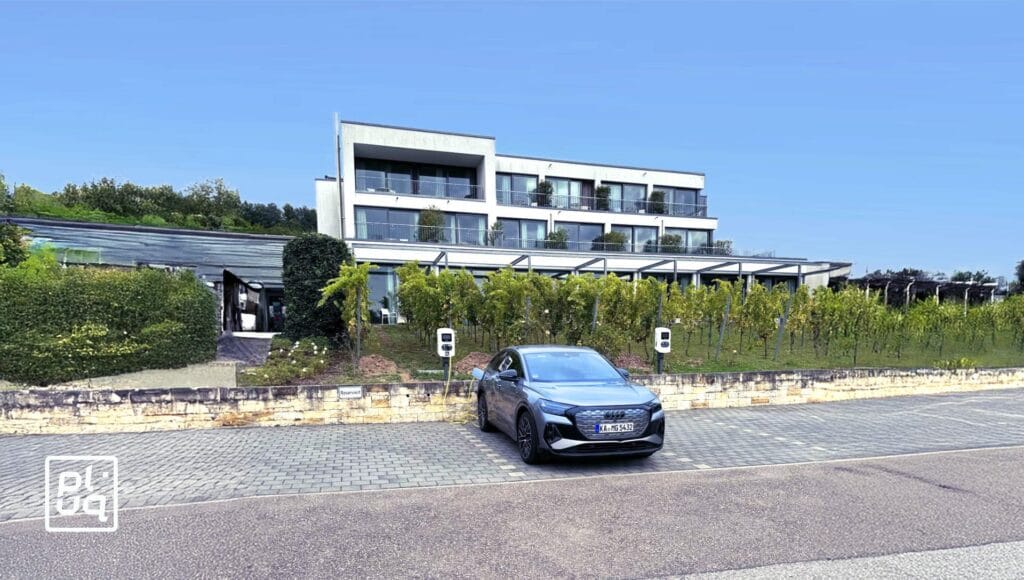Destination 484: Heitlinger Hof, Östringen, Germany.
With the rise of electric driving, the demand for reliable charging infrastructure is skyrocketing. Alongside home and highway charging, destination charging is a key pillar in the EV ecosystem.
This guide explains destination charging, its differences from other charging types, and why it is an essential feature for hotels, offices, hospitals, shopping centers, and leisure venues. We’ll also cover how to implement it and what to consider.
What is Destination Charging?
Destination charging refers to EV charging at locations where people stay for extended periods, typically two hours or more. Unlike fast charging, which is about topping up quickly and moving on, destination charging works in the background while people shop, work, relax, or sleep.
Most destination charging setups use AC charging stations ranging from 11 to 22 kW, which is ideal for gradual, efficient charging during the visitor’s stay. These stations are often installed in semi-public or private parking areas.
Typical destination charging locations include:
- Hotels and resorts
- Office parks and corporate campuses
- Hospitals and healthcare facilities
- Retail centres, supermarkets, and malls
- Theme parks, zoos, and cultural attractions
Destination charging is convenient, cost-effective, and increasingly expected by EV drivers.
How it differs from home and fast charging
- Home charging typically occurs overnight on private driveways using 3.7–11 kW chargers. It’s predictable but limited to EV owners.
- Fast Charging (DC, 50–350 kW) is found at service stations for short stops and high-speed top-ups. It’s effective, but costly and hard on vehicle batteries.
- Destination Charging sits in the middle: AC chargers (11–22 kW) are located at places where the EV is parked anyway. It’s ideal for workdays, overnight stays, or multi-hour activities like shopping or leisure.
With destination charging, users don’t have to make an extra stop to charge their EVs; they can charge while they go about their day.
Why Destination Charging Matters to EV Drivers
- Convenience: Charging occurs while users are already engaged in another activity—no need to divert or wait.
- Peace of mind: Knowing you can charge at your destination reduces range anxiety.
- Better for long trips: Charging overnight or during multi-hour stops makes journeys more efficient.
- Battery-friendly: Slow charging is gentler on EV batteries and puts less strain on the grid.
Destination charging is not just a perk—it’s increasingly seen as a basic expectation.
Why You Should Consider Offering Destination Charging
1. Happier guests and customers
Offering EV charging on-site is a clear service upgrade. Visitors love the convenience of leaving with a full battery, whether they’re staying overnight or visiting for a meeting. Charging availability boosts satisfaction and loyalty.
2. Longer visits, higher spending
If visitors know they can charge, they stay longer. This is especially relevant for retail and leisure locations—more time on site often means higher spending per visit.
3. Employee satisfaction
Charging at work is a valued perk for EV drivers and contributes to a progressive employer brand.
4. Competitive advantage
87% of EV drivers say charging options influence where they stay. Locations that offer charging are more likely to attract and retain customers.
5. More visibility
EV drivers actively search for chargers via apps. Get listed, and you could attract entirely new visitors.
6. Future-proofing
Charging infrastructure is becoming a regulatory requirement in many regions. Early adoption means lower costs and a stronger market position.
7. Sustainable branding
Charging shows a visible commitment to clean mobility. For organisations with ESG goals, it’s a practical step toward absolute emissions reduction.
Destination charging is smart business.
Key indicators when implementing destination charging
Number of chargers
Start with a few and scale with demand. Consider peak times and future growth.
Charging speed
Most destination chargers are 11 or 22 kW AC—ideal for long-stay scenarios.
Grid capacity and load balancing
Multiple chargers can strain your power supply. Use smart load balancing to distribute power and avoid costly grid upgrades.
Access and monetisation
Decide who can use your chargers (guests only, or public)—set access rules and pricing—free, pay-per-use, or a hybrid model.
Management software
Utilize backend software to monitor usage, manage access, and integrate with other systems (e.g., booking platforms or building energy management systems).
Energy efficiency
Connect to your site’s energy management or solar power—charge when the grid is quiet, or green.
Maintenance and support
Select a provider that provides proactive monitoring, regular updates, and a dedicated help desk support to ensure your stations operate smoothly.
Ready to become a charging destination?
Destination charging helps you stand out, satisfy your visitors, and meet tomorrow’s mobility standards today. Whether you run a hotel, office, mall, or leisure venue, charging on-site adds value.
Let’s explore how to turn your location into a trusted EV destination.

